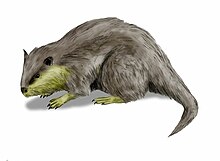河狸科
外觀
| 河狸科 化石時期:
| |
|---|---|

| |
| 美洲河狸(Castor canadensis) | |
| 科學分類 | |
| 界: | 動物界 Animalia |
| 門: | 脊索動物門 Chordata |
| 綱: | 哺乳綱 Mammalia |
| 目: | 齧齒目 Rodentia |
| 亞目: | 河狸亞目 Castorimorpha |
| 科: | 河狸科 Castoridae Hemprich, 1820 |
| 屬 | |
| |
河狸科(學名:Castoridae)是嚙齒目河狸亞目的一個科,包含多種化石物種,最早出現於始新世晚期。本科共有四個亞科,絕大多數物種已滅絕,現生物種只有一個屬(河狸屬)共兩種(美洲河狸與歐亞河狸)。
特徵
[編輯]
河狸是中型的哺乳動物,體型較多數其他囓齒類大,習性為半水生,體表光滑且後腳有蹼狀構造,尾巴扁平有鱗,有助於其在水中的移動。河狸可以樹枝、泥土等原料在河中建築水壩,以小家庭為單位居住,主要以樹葉等植物原料為食[1],其門齒發達,齒列式為1.0.1-2.31.0.1.3。
演化
[編輯]河狸科最早的類群為Agnotocastor屬,分布於始新世晚期至漸新世的北美洲與亞洲[2]。窄顱河狸屬(Steneofiber),分布於漸新世至中新世的歐洲,是河狸亞科最早出現的類群[3],其牙齒尚不適合啃木頭,顯示此為本科較晚出現的特徵[4] 。古河狸屬(Palaeocastor)則分布於中新世的北美洲。更新世時本科出現了若干體型較大的類群,包括歐洲的大河狸屬與美洲的巨河狸屬,其中後者的體型與美洲黑熊接近,但大腦的大小只比現生河狸大一點點[5]。
分類
[編輯]河狸科過去被分成河狸亞科與擬河狸亞科兩個亞科[6],兩者互為姊妹群,均為半水生、會築水壩的物種[2]。後來又新增Agnotocastorinae與Palaeocastorinae兩個亞科[3],包含本科中一些較早分支的類群,許多為擅長掘地的物種,習性與現生河狸差異較大[2]。以下列出河狸科之下的所有類群,其中大多數為已滅絕的化石物種 ,現生物種僅有一屬共兩種[註 1]。




- 河狸科 Castoridae
- †Migmacastor
- †Agnotocastorinae(並系群)
- †Agnotocastorini
- †Anchitheriomyini
- †近獸鼠屬 Anchitheriomys
- †Propalaeocastor
- †Propalaeocastor irtyshensis Wu, Meng, Ye et Ni, 2002[7]
- †Oligotheriomys
- †Oligotheriomys primus Korth, 1998
- †Palaeocastorinae
- †古河狸屬 Palaeocastor
- †Capacikala
- †Pseudopalaeocastor
- †Euhapsini
- †擬河狸亞科 Castoroidinae
- †Priusaulax(?)
- †Nothodipoidini
- †真河狸屬 Eucastor
- †Microdipoides
- †Nothodipoides
- †Castoroidini
- †單溝河狸屬 Monosaulax
- †Prodipoides
- †假河狸屬 Dipoides
- †巨河狸屬 Castoroides
- †Procastoroides
- †大河狸族 Trogontheriini
- †大河狸屬 Trogontherium
- †Boreofiber
- †Euroxenomys
- †楊氏河狸屬 Youngofiber
- †Asiacastor
- 河狸亞科 Castorinae
- †Chalicomys
- †窄顱河狸屬 Steneofiber
- †Steneofiber siamensis Suraprasit, Chaimanee, Martin & Jaeger 2011 [8]
- †Zamolxifiber
- †Romanofiber
- †Schreuderia
- †Sinocastor
- †豪狸屬 Hystricops
- 河狸屬 Castor
- 美洲河狸 Castor canadensis
- 歐亞河狸 Castor fiber
- †Castor californicus
註腳
[編輯]參考文獻
[編輯]- ^ Lancia, R.A.; Hodgdon, H.E. Macdonald, D. , 編. The Encyclopedia of Mammals. New York: Facts on File. 1984: 606–609. ISBN 0-87196-871-1.
- ^ 2.0 2.1 2.2 Rybczynski, N. Castorid phylogenetics: implications for the evolution of swimming and tree-exploitation in beavers. Journal of Mammalian Evolution. 27 December 2006, 14 (1): 1–35. doi:10.1007/s10914-006-9017-3.
- ^ 3.0 3.1 Korth, W.W. Comments on the systematics and classification of the beavers (Rodentia, Castoridae). Journal of Mammalian Evolution. December 2001, 8 (4): 279–296. doi:10.1023/A:1014468732231.
- ^ Palmer, D. (編). The Marshall Illustrated Encyclopedia of Dinosaurs and Prehistoric Animals. London: Marshall Editions. 1999: 284. ISBN 1-84028-152-9.
- ^ Savage, R.J.G., and Long, M.R. 1986. Mammal Evolution: an Illustrated Guide. Facts on File, New York, pp. 120–121 ISBN 0-8160-1194-X.
- ^ McKenna, Malcolm C., and Bell, Susan K. 1997. Classification of Mammals Above the Species Level. Columbia University Press, New York, 631 pp. ISBN 0-231-11013-8.
- ^ Wu, W., Meng, J., Ye, J. and Ni, X. 2002. Propalaeocastor (Rodentia, Mammalia) from the early Oligocene of Burqin Basin, Xinjiang. American Museum Novitates. 3461: 1–16. doi: dx.doi.org/10.1206/0003-0082(2004)461<0001:PRMFTE>2.0.CO;2
- ^ Suraprasit, K., Y. Chaimanee, T. Martin, and J. -J. Jaeger. 2011. First Castorid (Mammalia, Rodentia) from the middle Miocene of Southeast Asia. Naturwissenschaften. 98(4):315-28. DOI: dx.doi.org/10.1007/s00114-011-0769-0

